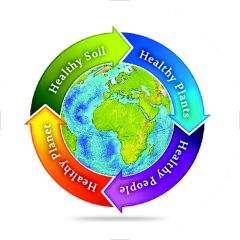which they do with the help of Enzymes.
For over 125 million years, the earth has sustained itself by recycling organic, enzyme-rich substances. As animals, insects, worms, micro- and other organisms consume plant matter, they also consume the enzymes of that plant matter, and rely on those enzymes for proper health, growth and development.
Synthetic, chemical, enzymeless fertilizers were developed about 50 or 60 years ago. These fertilizers often rely solely on N-P-K nutrients, ignoring the necessary interactions between all biological compounds of healthy plant cell growth and development.
Shortly, after the introduction of and increased use of synthetic, chemical, enzymeless fertilizers, plants began weakening, could not hold their own, and began to be attacked and afflicted with numerous ailments which had been no real problem when natural, organic enzyme fertilizers were used. Lower resistance to disease, damage, and stress have been among the consequences.
The chemical and synthetic enzymeless fertilizer substitutes weaken vegetables and other food plants, building up a hidden preclinical entity, a state of “disease” that is a prelude to disease. Modern crops cannot stand on their own in the absence of adequate supplies of enzymes.
This weak state of fruit, vegetable, and produce food can be a factor in many serious human diseases. Though there is still much research to be done regarding vitamin synthesis in plants, vegetables, fruits, and other produce, several recent studies have shown vitamins are likely metabolized by a reaction involving enzymes. Studies have shown decreasing levels of vitamins and other nutrients in produce grown today versus produce grown just 50 years ago. Fewer enzymes, vitamins and minerals in produce means less nutrition available to humans and animals. These substances are essential to healthy growth, development, and immunity support.
Adequate bacteria and fungal populations are essential in helping to break down organic matter. These bacteria and fungi help produce enzymes, which assist in breaking down fallen leaves, bark, dead plant material, and other organic matter, freeing available nutrients (as in nitrogen-fixing), which the fungi & bacteria can then more easily digest and metabolize. For example, the enzyme Phosphatase works to break down Phospate, which is a mineral, into simpler forms such as OrthoPhosphate. Plants
Humic substances are a good source of energy for beneficial soil organisms. Humic substances and non humic (organic) compounds provide the energy and many of the mineral requirements for soil microorganisms and soil animals. Beneficial soil organisms lack the photosynthetic apparatus to capture energy from the sun thus must survive on residual carbon containing substances on or in the soil. Energy stored within the carbon bonds functions to provide energy for various metabolic reactions within these organisms. Beneficial soil organisms (algae, yeasts, bacteria, fungi nematodes, mycorrhizae, and small animals) perform many beneficial functions which influence soil fertility and plant health. For example the bacteria release organic acids which aid in the solubility and bioavailability of mineral elements bound in soil. Bacteria also release complex polysaccharides (sugar based compounds) that help create soil crumbs (aggregates). Soil crumbs give soil a desirable structure.
Other beneficial soil microorganisms such as the Actinomyces release antibiotics into the soil. These antibiotics are taken up by the plant to protect it against pests. Antibiotics also function to create desirable ecological balances of soil organisms on the root surface (rhizoplane) and in soil near the roots (rhizosphere). Fungi also perform many beneficial functions in soils. For example, mycorrhizae aid plant roots in the uptake of water and trace elements. Other fungi decompose crop residues and vegetative matter releasing bound nutrients for other organisms. Many of the organic compounds released by fungi aid in forming humus and soil crumbs. Beneficial soil animals create tunnel like channels in the soil. These channels allow the soil to breath, and exchange gases with the atmosphere. Soil animals also aid in the formation of humus, and help balance the concentration of soil microorganisms. A healthy fertile soil must contain sufficient carbon containing compounds to sustain the billions of microscopic life forms required for a fertile soil and a healthy plant.
A living soil is a fertile, healthy soil.
